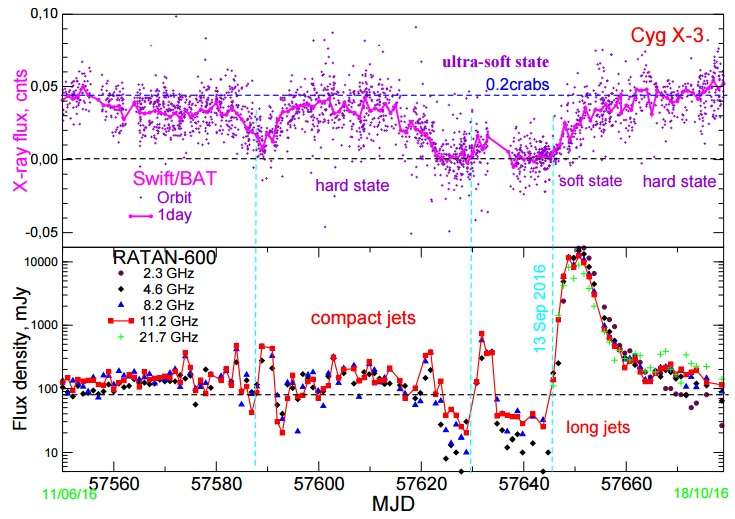December 7, 2016 report
Giant radio flare of Cygnus X-3 detected by astronomers

(Phys.org)—Russian astronomers have recently observed a giant radio flare from a strong X-ray binary source known as Cygnus X-3 (Cyg X-3 for short). The flare occurred after more than five years of quiescence of this source. The discovery was presented in a paper published Dec. 2 on the arXiv pre-print server.
Classified as a microquasar, Cygnus X-3 is a powerful X-ray source believed to be a compact object in a binary system. It was originally discovered in X-rays in 1967 and is observable in X-rays, gamma rays, infrared and radio. The source is located some 23,000 light years away in the constellation Cygnus and has an orbital periodicity of approximately 4.8 hours.
Cygnus X-3 experiences periodic radio outbursts. The first recorded significant flare took place in 1972 and increased the radio frequency emissions from this source a thousandfold. More recently, in March 2011, astronomers recorded a giant flare, and after this event, the source went into a state of dormancy.
The phase of quiescence was interrupted by the last giant radio outburst that took place in September 2016, and was predicted by a team of astronomers led by Sergei Trushkin of the Special Astrophysical Observatory (SAO) in Nizhnij Arkhys, Russia. The researchers observed Cygnus X-3 with SAO's RATAN-600 radio telescope as part of a long-term, multi-frequency monitoring campaign of microquasars.
"In the long-term multi-frequency monitoring program of the microquasars with RATAN-600, we discovered the giant flare from X-ray binary Cyg X-3 on September 13, 2016," the scientists wrote in the paper.
According to the research, Cygnus X-3's 2016 outburst interrupted a nearly five-and-a-half-year period of its quiescence. The flare of 2016 occurred after transition of the source to a 'hyper-soft' X-ray state, as in the case of the previous outburst in 2011.
The scientists revealed that the flux of the 2016 flare rose from 0.01 to 15 Jy at 4.6 GHz over five days. Afterward, the microquasar returned to a quiescent state on Oct. 18, 2016.
"The rise of the flaring flux is well fitted by a exponential law that could be a initial phase of the relativistic electrons generation by internal shock waves the jet," the team explained.
Besides detecting and characterizing the 2016 outburst, the researchers also found that during the period of dormancy preceding the latest flare, hard X-ray flux were strongly anti-correlated. They assume that this could be related with properties of the compact radio jets that form during a quiescent state, and strongly depend on a rate of accretion on to a black hole or a neutron star.
"The accretion disk-jet coupling in X-ray binaries has been discussed during last 10 to 15 years, especially in the frame of the hardness-intensity diagram (HID) studies. (…) The spectral evolution of the giant flare is described by a single (during three to four days) ejection of the relativistic electrons, that moved with high velocity (0.5c) away from the binary and expanded as a conical structure," the paper reads.
The team plans to present the results of other observations of the Cygnus X-3's flare conducted using different telescopes, which could help in making a more thorough analysis of this microquasar's violent outbursts. New measurements will be published in the upcoming research papers.
More information: The giant radio flare of Cygnus X-3 in September 2016, arXiv:1612.00634 [astro-ph.SR] arxiv.org/abs/1612.00634
© 2016 Phys.org




















